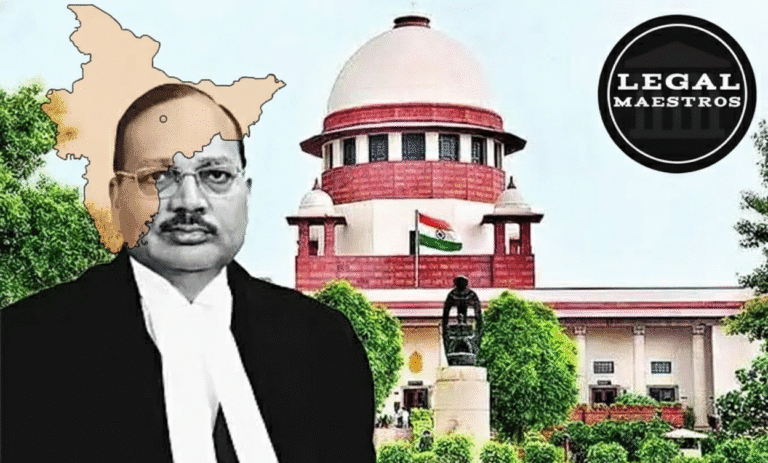
This is an important judgment issued by the Supreme Court of India in the case of Singamasetty Bhagavat Guptha and Anr. v. Allam Karibasappa (D) by LRs. Ors., which is a significant clarification of how insolvency has been annulled in the law and the validity of an action made in case of insolvency. The case occurred around the conflict involving the partition of a partnership and the significance of the appropriate legal procedure and the functions of the appellate courts in analyzing evidence.
A Partnership Controversy and the commencement of Insolvency.
The case started with a partnership company, M/s Gavisiddeshwara & Co., a company that was established in 1963 and later reconstituted to incorporate other partners. In the year 1975, one of the partners by the name Sri Singamasetty Subbarayudu died, and his son, the appellant, was made a partner. The appellant supposedly offered to sell his one-anna portion share in the firm to the other partners as a result of the huge debts left by his father. A contract was ended at an amount of about Rs. 95,000 and the original applicant Sri Allam Karibasappa said that he had accepted this offer.
Creditors of the appellant filed insolvency proceedings against him and his mother by the Provincial Insolvency Act, 1920 before a formal transfer deed could be executed. The District Court in 1977 declared them insolvent, and placed a receiver in charge of the assets. Sri Karibasappa then proceeded to the District Court claiming that there was a concluded contract before the announcement of the insolvency and he was due the share of the appellant. Agreeing with this, the District Court ordered the official receiver to hand over the share to him, and that was executed through a registered transfer deed on March 11, 1983.
For any queries or to publish an article or post or advertisement on our platform, do call at +91 6377460764 or email us at contact@legalmaestros.com.
The Legal Ramifications of the Annulment.
The appellants appealed the decision of the District Court, and during the appeal, they were able to get the insolvency proceedings annulled in 1996, after having settled the majority of their debts. In its order to annul, the District Court observed that the imminent appeal in the High Court would not have an influence on the annulment. Upon the annulment, the High Court vacated the District Court order in 1983 and the transfer deed and retrialed the issue before the District Court in 1984.
When the case was remanded, the District Court was able to dig deep into the facts and found that the purported offer and acceptance letters of 1975 were forged. According to the court, the official receiver had also cast some doubts on the authenticity of these documents considering that the originals were never in existence. The court ruled that the documents were got up to serve the interest of the claimant and was not safeguarded under the section 55 of the Act, which protects bona fide transactions only effected prior to the insolvency adjudication. The District Court, therefore, dismissed the demands to transfer a partnership share and canceled the transfer deed of 1983.
The Supreme Court v. the High Court of Having Made a Mist.
The respondents were not happy with the results of the District Court and thus filed an appeal to the High Court. The High Court however overturned the decision of the District Court, and held that the transfer deed of 1983 was not invalid due to the fact that it was covered by Section 37(1) of the Provincial Insolvency Act. It is provided in this section that any sale and dispositions of property made by the court and receiver shall be valid in case an insolvency adjudication is annulled and the sale and dispositions were duly made. The High Court argued that the assets had vested in the official receiver and the sale deed was unchallenged and therefore, was valid.
For any queries or to publish an article or post or advertisement on our platform, do call at +91 6377460764 or email us at contact@legalmaestros.com.
The Supreme Court established that the High Court had made a grave fallacy in its argument. The verdict of the High Court was founded on a false premise that the deed of transfer that took place in 1983 was already final. Yet the Supreme Court had indicated that the High Court itself, in an earlier order had suspended the very order of the District Court upon which the deed of transfer was founded and had sent the case back to be revisited. Consequently, the transfer act was not legally founded.
The Significance of the Review of Appeal and Due Process.
The Supreme Court emphasized one of the major principles in the appellate jurisdiction the obligation to reappraise the evidence adequately. The High Court in its decision had merely brushed aside the determination of the District Court on the forged documents by merely stating that the decision was made based on mere guesses and speculation and had not taken its own independent examination of the facts. The Supreme Court referred to the existed jurisprudence, where the reversal of a judgment of a trial court by an appeal court is obligatory to come into the immediate contact with the arguments of the former and present its reasons to reach another conclusion. This is a jurisdictional error that the High Court made.
In conclusion, the Supreme Court held that in order to have a transaction which is duly made and safeguarded under Section 37 of the Act, the transaction must have been finalized via a due legal process. On remand, the District Court had in this case determined that the entire basis of the entire transaction including the so-called offer and acceptance has been fraudulent. Thus, the transfer was not a duly made act which could be safeguarded by the law. The Supreme Court sided with the decision of the District Court, quashed the appeals of the respondents and returned to the appellant what was rightfully theirs, the share of the partnership. The case is also a compelling lesson that despite the fact that insolvency annulment may be used to recover the property of a debtor, it does not legitimize fraudulent or otherwise unlawful transactions.
For any queries or to publish an article or post or advertisement on our platform, do call at +91 6377460764 or email us at contact@legalmaestros.com.




![Research Assistantship @ Sahibnoor Singh Sindhu, [Remote; Stipend of Rs. 7.5k; Dec 2025 & Jan 2026]: Apply by Nov 14, 2025!](https://legalmaestros.com/wp-content/uploads/2025/11/Gemini_Generated_Image_s0k4u6s0k4u6s0k4-768x707.png)
![Karanjawala & Co Hiring Freshers for Legal Counsel [Immediate Joining; Full Time Position in Delhi]: Apply Now!](https://legalmaestros.com/wp-content/uploads/2025/11/Gemini_Generated_Image_52f8mg52f8mg52f8-768x711.png)
![Part-Time Legal Associate / Legal Intern @ Juris at Work [Remote]: Apply Now!](https://legalmaestros.com/wp-content/uploads/2025/11/ChatGPT-Image-Nov-12-2025-08_08_41-PM-768x768.png)
![JOB POST: Legal Content Manager at Lawctopus [3-7 Years PQE; Salary Upto Rs. 70k; Remote]: Rolling Applications!](https://legalmaestros.com/wp-content/uploads/2025/11/ChatGPT-Image-Nov-12-2025-08_01_56-PM-768x768.png)